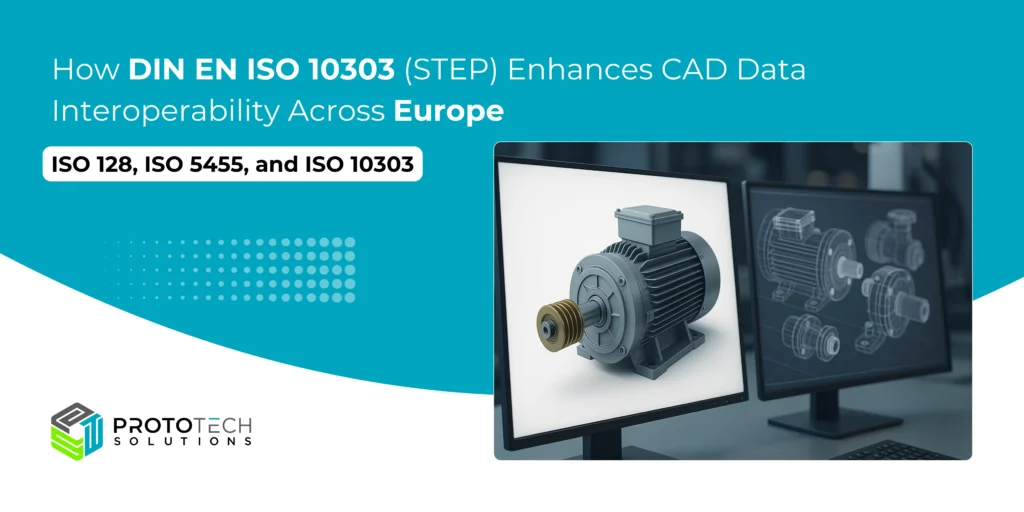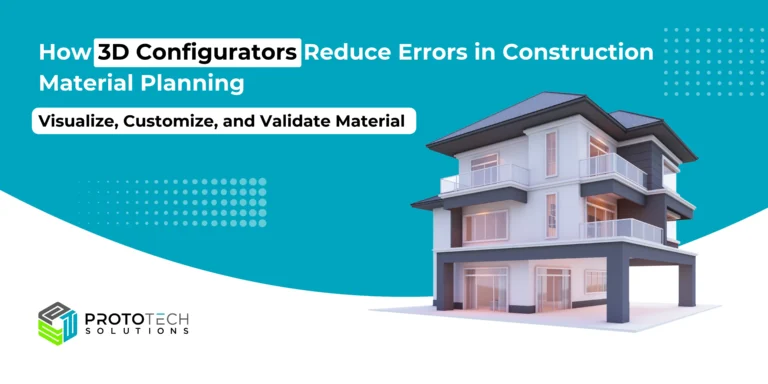How DIN EN ISO 10303 (STEP) Enhances CAD Data Interoperability Across Europe

Computer-Aided Design (CAD) is integral to modern product development, manufacturing, and engineering. In Europe, standardization ensures that technical drawings and product data remain clear, consistent, and compliant with legal requirements across borders and industries.
Across Germany and Europe, technical standards such as DIN EN ISO 128 (Technical product documentation (TPD) ), DIN EN ISO 5455 (Technical Drawings—Scales), and DIN EN ISO 10303 (Industrial automation systems and integration — Product data representation and exchange). These, along with various industry-specific regulations, form the backbone of seamless collaboration and data exchange in the industrial sector, particularly as the European Union emphasizes harmonized legislation and digital innovation.
This blog explores how DIN EN ISO 10303 (STEP) in particular revolutionizes CAD data interoperability across Europe, enabling manufacturers, engineers, and technology providers to overcome longstanding barriers of incompatibility and siloed workflows.
Understanding the Landscape of Engineering Standards in Europe
DIN, EN, and ISO: What Do They Mean?
- DIN: Deutsches Institut für Normung (German Institute for Standardization) is responsible for national standards in Germany.
- EN: European Norms are standards adopted by European standardization bodies (CEN, CENELEC, ETSI) to ensure cross-border compliance.
- ISO: The International Organization for Standardization develops global standards to unify practices across industries.
When a standard is designated as DIN EN ISO, it means it has been adopted at the international, European, and national levels. This multi-tier endorsement ensures wide applicability across industries in Germany and Europe.
Key Standards in Technical Drawing and CAD Data
- DIN EN ISO 128: This standard defines the principles for preparing technical drawings, applicable to both manual and computer-based documentation. It outlines the basic conventions in representing objects, views, and dimensions, providing a common graphical language for engineers and designers across Europe.
- DIN EN ISO 5455: Defines standardized scales in technical drawings, essential for accurate design interpretation, manufacturing, and quality control. It specifies the designation and correct use of scales, ensuring that drawings can be easily compared and integrated, regardless of the country or software used.
- DIN EN ISO 10303 (STEP): STEP is the definitive international standard for computer-interpretable data representation and exchange among product modeling applications. Its goal: to achieve full interoperability between disparate CAD, CAE, and CAM software, supporting the entire product lifecycle from initial concept to long-term archival.
While the first two standards govern how drawings are made and interpreted, ISO 10303 addresses the core challenge of data exchange and interoperability in a CAD-driven design environment. European CAD interoperability also depends on sector-specific rules, such as those from the European Committee for Standardization (CEN), and harmonized regulations under the EU’s New Legislative Framework (NLF), which tie safety, quality, and environmental criteria to technical standards and enforced legislation.
What Is DIN EN ISO 10303 (STEP)?
DIN EN ISO 10303, or STEP, stands for Standard for the Exchange of Product Model Data. It is a comprehensive ISO standard designed to describe and exchange product data throughout the entire lifecycle from design to manufacturing and maintenance.
Unlike native CAD file formats (such as .dwg, .prt, or .sldprt), which are often proprietary and vendor-specific, STEP provides an open, neutral file format (.stp or .step) that can be used across multiple platforms and software environments.
Key Features of STEP
- Neutral, vendor-independent format.
- Enables data exchange between different CAD systems (e.g., CATIA, SolidWorks, Siemens NX).
- Supports complex assemblies, geometry, metadata, manufacturing features, and Product Manufacturing Information (PMI).
- Extensible, with specific Application Protocols (APs) tailored to different sectors (e.g., AP203, AP214, AP242 for mechanical design and product data management).
- Enables both file-based transfers and direct system-to-system interoperability.
- Suitable for both “as-designed” and “as-manufactured” data.
- Facilitates long-term archival for regulatory or historical purposes.
The Importance of CAD Data Interoperability
The Challenge of Disconnected Systems
In the European industrial ecosystem, companies often collaborate across borders and sectors. However, each organization may use a different CAD system, making file sharing cumbersome. Without a common format, designers must rely on error-prone and time-consuming file conversions or re-modeling.
How STEP Bridges the Gap
STEP acts as a universal translator between CAD systems, eliminating data silos. Whether you’re a German automotive supplier using CATIA or an Italian aerospace firm working with Siemens NX, STEP allows you to seamlessly exchange data without loss of fidelity.
Benefits of STEP for CAD Interoperability in Europe
- Enhanced Collaboration: With a common data exchange format, teams across borders and departments can work on the same product model, regardless of their native software. This fosters collaboration among Original Equipment Manufacturers (OEMs), suppliers, and contractors.
- Eliminating Vendor Lock-In: With Europe’s diverse manufacturing landscape, company partnerships often involve different CAD platforms. STEP’s open, standardized format removes barriers between systems such as Catia, Siemens NX, PTC Creo, SolidWorks, and others, eliminating costly and error-prone manual rework when exchanging files.
- Enabling Digital Twins and Model-Based Engineering: STEP supports the digital thread across design, manufacturing, and PLM (Product Lifecycle Management) systems. This enables advanced practices like digital twin development, model-based definition, and long-term data retention, core tenets of Industry 4.0 across Europe.
- Supporting Regulatory Compliance and Traceability: Harmonized standards under the NLF and specific European directives often require comprehensive traceability, archival, and audit of design data. STEP files provide this, meeting compliance demands in highly regulated sectors such as automotive (UNECE, CEN/TC 301) and construction.
- Reduced Errors and Rework: By minimizing data loss during translation, STEP files preserve the original design intent. This reduces costly errors in manufacturing and downstream processes.
Conclusion
German and European industries increasingly rely on collaborative, multi-platform CAD environments. DIN EN ISO 10303 (STEP) has transformed the way CAD data travels throughout Europe’s manufacturing and engineering landscape. By providing a robust, vendor-neutral foundation, STEP bridges the gap between diverse software systems, geographic boundaries, and regulatory frameworks.
ProtoTech Solutions stands out as a strategic partner in achieving seamless CAD data interoperability. With deep expertise in CAD/BIM software development, file format conversions, and 3D visualization, ProtoTech helps engineering firms, OEMs, and software vendors implement DIN EN ISO 10303 (STEP) standards effectively across their workflows.
If you’re ready to unlock seamless data exchange and compliance in your next project, connect with ProtoTech’s interoperability experts and join leading German and European innovators shaping the future of digital engineering. This positions them for success in the evolving landscape of Industry 4.0 and cross-border digital collaboration. Request a Custom CAD Interoperability Solution






